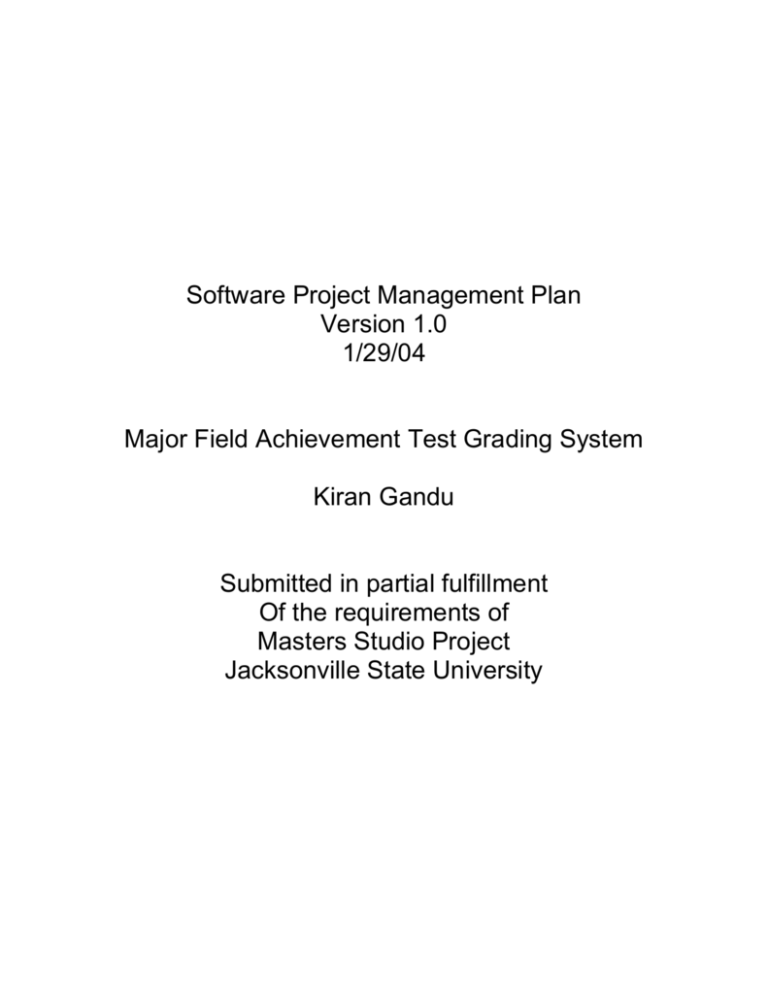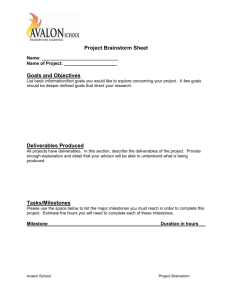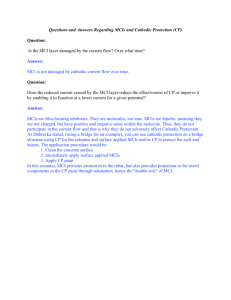Sample SPMP - Mathematical, Computing, & Information Sciences
advertisement

Software Project Management Plan Version 1.0 1/29/04 Major Field Achievement Test Grading System Kiran Gandu Submitted in partial fulfillment Of the requirements of Masters Studio Project Jacksonville State University Change History Major Field Achievement Test SPMP Version 1.0 Release date: 1/29/04 Baseline Version Preface The purpose of this document is to specify the project plan to develop the Major Field Achievement Test (MFAT) grading system. The primary audience is the project advisor, Dr Dennis S. Martin, and other members of the studio committee, Dr Chi-Chin Chao and Dr Jan Case. This document outlines a brief plan about how the project is to be shaped and also includes the milestones and deliverables. The SPMP document will serve as a guide for the student, developing the product as part of the project. Updates of this document will serve to record the progress of the project. iii Table of Contents Change History ............................................................................................................................................... ii Preface ........................................................................................................................................................... iii Table of Contents .......................................................................................................................................... iv List of Figures ................................................................................................................................................ v 1.0. Overview ................................................................................................................................................. 1 1.1. Project Summary ............................................................................................................................ 1 1.1.1. Scope, Purpose and Objectives ............................................................................................... 1 1.1.2. Assumptions and Constraints ................................................................................................. 3 1.1.3. Project Deliverables ................................................................................................................ 3 1.1.4. Schedule and Budget Summary .............................................................................................. 4 1.2. Evolution of the Plan ...................................................................................................................... 5 2.0. References .......................................................................................................................................... 6 3.0. Glossary .............................................................................................................................................. 7 4.0. Project Organization ........................................................................................................................... 8 4.1. External Interfaces .......................................................................................................................... 8 4.2. Internal Interfaces ........................................................................................................................... 8 4.3. Roles and Responsibilities .............................................................................................................. 8 5.0 Managerial Process Plans ................................................................................................................... 9 5.1. Work Plan ....................................................................................................................................... 9 5.1.1. Work Activities....................................................................................................................... 9 5.1.2. Schedule Allocation ................................................................................................................ 9 5.1.3. Resource Allocation ..............................................................................................................10 5.1.4. Budget Allocation ..................................................................................................................10 5.2. Control Plan ...................................................................................................................................10 5.2.1. Requirements Control Plan ....................................................................................................10 5.2.2. Schedule Control Plan ...........................................................................................................10 5.2.3. Budget Control Plan ..............................................................................................................10 5.2.4. Quality Control Plan ..............................................................................................................10 5.2.5. Reporting Plan .......................................................................................................................11 5.2.6. Metrics Collection Plan .........................................................................................................11 5.3. Risk Management Plan ..................................................................................................................11 5.4. Closeout Plan .................................................................................................................................12 6.0 Technical Process ..............................................................................................................................13 6.1. Process Model ...............................................................................................................................13 6.2. Methods, Tools, and Techniques ...................................................................................................13 6.3. Infrastructure Plan .........................................................................................................................13 6.4. Product Acceptance Plan ...............................................................................................................13 7.0 Support Process Plans........................................................................................................................14 7.1. Configuration Management Plan ...................................................................................................14 7.2. Validation & Verification Plan ......................................................................................................14 7.3. Documentation Plan ......................................................................................................................14 7.4. Quality Assurance Plan .................................................................................................................15 7.5. Review and Audits.........................................................................................................................15 7.6. Problem Resolution Plan ...............................................................................................................15 7.7. Subcontractor Management Plan ...................................................................................................15 7.8. Process Improvement Plan ............................................................................................................15 iv List of Figures 1. Figure.1 Schedule 2. Figure 2. Gantt Chart v 1.0. Overview 1.1. Project Summary 1.1.1. Scope, Purpose and Objectives The CMMI is a model for improving and appraising the performance of development organizations. It stands for “Capability Maturity Model Integration”. It is published and developed by the Software Engineering Institute in Pittsburgh, PA. The CMMI is best known for its five levels of organizational maturity namely initial, managed process, defined process, and quantitatively managed process and optimizing process. Each level represents a coherent set of best practices organizations are expected to implement as they become better at what they do. CMMI methodology at Level 5 (optimizing process) of requires that an organization assess its performance against certain parameters and use this information for process improvement. This applies to university programs as well as to the software development organizations. For Computer Science there is a nationally nor med test developed by the Educational Testing Service, which will provide comparative national results. Dr. Martin had suggested that the Computer Information Systems (CIS) program at Jacksonville State University needs something similar to this. The test would have to be based on multiplechoice type questions and cover the entire course curriculum. It would have subparts covering the main areas of CIS to allow for more specific evaluation of the curriculum. The department also feels the need for a locally written test in Computer Science that has 1 a similar sub area structure. The objective of the new system will be to provide an efficient way to grade and report results for the MCIS MFAT. This project proposes a system for use on a Personal Computer using a Visual Interface and the Microsoft Access database management system. Major functions that will be provided by the system include: logging into the system, importing answer keys and student test answers, grading tests, generating a report of test results and printing reports upon demand. The MCIS department will use the Major Field Achievement Test to gauge the overall performance of its students in the computer field. This project will deliver a working system that provides results of such tests not only for evaluating the student but also for using such information by the department for its improvement. A project like this is an excellent opportunity for the author to have a real world experience while testing and implementing the knowledge that was gained during the Masters program and especially undergoing the Software Engineering courses. It would be worthwhile to use the experience that the author had gained experience working on databases. The MCIS Department can assess its performance and use this information for its process improvement as one of the steps necessary for accreditation of the program. 2 1.1.2. Assumptions and Constraints The author of this document is expected to complete the project within two semesters. This project will use resources in the form of time and effort that will be spent developing the project deliverables and under the guidance of Dr. Martin, who kindly agreed to be the advisor and a guide for this project. My advisor has said that a databank of questions would be made available, as a baseline database for the MFAT implementation for CIS, and simulated student response data will be provided for the project. Of course, this databank can be modified and updated at any point of time in the future by the faculty or the department. 1.1.3. Project Deliverables The list of project deliverables is: Project Management Plan Software Requirements Specification Software Design Description Software Quality Assurance Plan (including the Software Verification and Validation Plan and the Test Design Document) Working System with an Access Database Final Studio Document Refer to section 1.1.4 for the expected delivery dates of the project deliverables. 3 1.1.4. Schedule and Budget Summary Budget Summary: “No budget required”. A tentative schedule is as shown below in table 1. Figure 1: Schedule Item Due date Software Project Management Plan (this document) January 29, 2004 Software Requirements Specifications February 27, 2004 Software Design Document March 18, 2004 Software Quality Assurance and Verification & April 05, 2004 Validation Plan Studio I Presentation April 15, 2004 Updated SPMP September 20, 2004 Database October 08, 2004 Software Testing Description October 28, 2004 System Integration November 16, 2004 Final Studio Paper November 25, 2004 Studio II Presentation December 2, 2004 4 1.2. Evolution of the Plan The preliminary drafts of the SPMP will be submitted to my advisor and after approval, copies of the same will be distributed to the members of the committee on the date as referred to in section 1.1.4, figure 1. For configuration management, refer to section 7.1, configuration management plan. 5 2.0. References 1. Braude, Eric J., Software Engineering: An Object Oriented Perspective. Wiley, 2001. 2. Case Study: SPMP for Encounter video game ref: http://www.wiley.com/college/braude. 3. IEEE Document Standards published in “IEEE Standards Collection”. 2001 edition. 4. Major field test administered by the ETS: http://www.ets.org/hea/mft/index.html 5. Martin, Dr. Dennis S., Documentation Standards. Jacksonville State University, 2003: http://mcis.jsu.edu/faculty/dmartin/cs521.html 6. Pressman, Roger S., Software Engineering: A Practitioner’s Approach. McGraw-Hill, 2001. 6 3.0. Glossary Term CIS Description Computer Information Systems program within the MCIS Dept CMMI Capability Maturity Model Integration CS Computer Science program within the MCIS Dept ETS Educational Testing Services Mathematics Also a program within the MCIS Dept MCIS Mathematical, Computing and Information Sciences Department MFAT Major Field Achievement Test RDBMS Relational Database Management System. SCMP Software Configuration Management Plan SDD Software Design Document SQAP Software Quality Assurance Plan SRS Software Requirement Specification. Stakeholder A person, group or organization with a stake in the outcome of an application that is being developed. TDB / tbd To be decided 7 4.0. Project Organization 4.1. External Interfaces The external interfaces for the project would be the members of the studio committee and Mrs. Judy Anderson, Secretary, Department of MCIS who is the stakeholder for this project. 4.2. Internal Interfaces None. 4.3. Roles and Responsibilities The software developer is responsible for all documentation to be developed and for all work to be done. 8 5.0 Managerial Process Plans 5.1. Work Plan 5.1.1. Work Activities Refer to section 5.1.2 Gantt chart. 5.1.2. Schedule Allocation Figure 2: Gantt chart MFAT Grading System Project Schedule Kiran: Project Developer Status date: January 8th, 2004 Due Date: December 2nd, 2004 Activity % Complete User Analysis 0 Full Specification 0 Architectural 0 Design Detailed Design 0 Database 0 Test Design 0 Implementation 0 Module Testing 0 Integration Testing 0 Status S S S 1/29 2/27 3/18 SSSSS SSSSSSSS SSSSSSSS S S S S S S Schedule Satisfactory Caution Critical Planning / Progress Symbols B S A X 11/16 SSSSSSSS SSSSSSS SSSSSSS SSSSSSSSS SSSSSSSSSSSSS SSSSSSSSSSSSS Project Status Symbols S A C F Date Ending 10/08 10/28 Work before Schedule Time Scheduled Activity Time Work after Scheduled Time Scheduled But Not Worked 9 5.1.3. Resource Allocation This project will use resources in the form of time and effort that I shall spend developing the project deliverables as mentioned in section 1.1.3. 5.1.4. Budget Allocation None. 5.2. Control Plan 5.2.1. Requirements Control Plan When changes are to be made in the requirements after the SRS has been released, the changes shall be brought to the attention of the committee and discussed. Any changes that are to be made will be with the prior approval of the committee and only if feasible and permissible within the constraints of the project mentioned in section 1.1.2, and resources in terms of knowledge and skill of the developer required. Once the changes have been made to the SRS document, an updated version of the SRS shall be released and circulated to the committee. However, no changes shall be made to the requirements once the SDD is completed. 5.2.2. Schedule Control Plan If the work scheduled in section 1.1.4 is gets behind, the developer is ready to spend extra time on the project in between and after the schedules and also during Summer 2004 to make up for the lost time and deliver the final project on time. 5.2.3. Budget Control Plan 5.2.4. Quality Control Plan None. Please refer to Software Quality Assurance Plan regarding Quality Control. 10 5.2.5. Reporting Plan The updated SPMP will be circulated as mentioned in schedule of section 1.1.4. Each of preliminary versions of all the documents and updates and status reports will be sent and discussed with the advisor and upon approval the approved document will be circulated to the other members of the committee. The report on the status of the project will be sent to the members of the committee at the beginning of the second semester of Studio. 5.2.6. Metrics Collection Plan None. 5.3. Risk Management Plan Risk # 1 “Deficiency in the knowledge and understanding of the problem and its solution” indicates that the developer does not have the complete understanding of the problem. This will affect the quality of the project in terms of requirements of the product and their fulfillment, which is not desirable. Building a prototype for the project model and doing an extensive literature search can overcome this. This will help the developer in delivering an efficient and quality product. Risk # 2 “Lack of Skills and knowledge of tools needed for statistical analysis”, which means that the developer does not have knowledge about the tools and knowledge of working on statistical analysis. In this case, the developer is expected to update his / her knowledge of tools available for this purpose and decide the one that will be used in the project and master it. The developer may consult the faculty and other members of the committee especially, Dr. Jane Case for this purpose. 11 5.4. Closeout Plan All the details about the post-mortem debriefings, report on the lessons learnt, project objectives and the milestones achieved would be mentioned as part of the final studio paper at the end of the first semester of the studio component. At the end of the second semester of studio the developer will provide the committee with electronic version of the project code and documentation for future reference and maintenance purposes. 12 6.0 Technical Process 6.1. Process Model The MFAT grading system for MCIS will be implemented and executed using the Waterfall Model and prototyping. 6.2. Methods, Tools, and Techniques Refer to section 6.1 (process model) for a description of the process. This process is described in [Braude] Software Engineering: An Object Oriented Perspective. This project adapts the system for use on a Personal Computer using a Visual Interface that would be built using Visual basic 6.0 and HTML, and Microsoft Access as its database management system. The tool for the statistical analysis is undecided at this point of time and would be mentioned in the updated version of this document. 6.3. Infrastructure Plan The hardware resources are two 333MHz Pentium computers running Windows 95 / 98 / 2000 Operating System. Each of these computers should have at least 128 MB RAM and a minimum of 4 GB of disk space. 6.4. Product Acceptance Plan The committee will test the final product / application for acceptance. 13 7.0 Support Process Plans 7.1. Configuration Management Plan All the project deliverables are to be considered as configuration items. The configuration item as well as its file would be named after the document like SRS, SDD and followed by the version number. For example, all the preliminary versions that are submitted to the advisor for review would be named with the abbreviation followed by 0.1, 0.2. After the advisor approves the basic SPMP, this baseline document will be version 1.0 and is distributed to the committee members and stakeholders. Informal updates with the advisor will be numbered with 1.1, 1.2, etc. and the next full distribution to the committee would be version 2.0, etc. 7.2. Validation & Verification Plan A Verification and Validation Plan as a part of the Software Quality Assurance and Verification & Validation Plan will be developed following recommended departmental standards. See section 1.1.4 for its delivery date. 7.3. Documentation Plan The IEEE standards would be followed for all documentation purposes. All the documents would be discussed and reviewed with advisor before their baseline versions are issued and distributed to the members of the committee on the due dates mentioned in section 1.1.4 for delivery dates. 14 7.4. Quality Assurance Plan A Software Quality Assurance Plan will be developed following recommended departmental standards. See section 1.1.4 for its delivery date. 7.5. Review and Audits Review and Audits would be addressed as a part of the Software Quality Assurance and Verification & Validation Plan that would be developed following recommended departmental standards. See section 1.1.4 for its delivery date. 7.6. Problem Resolution Plan None, problems would be resolved informally between the developer, the advisor and the studio committee. 7.7. Subcontractor Management Plan None. 7.8. Process Improvement Plan None, this is a single software development experience and the lessons learned will be included in the final studio document. 15 Index A Application 1, 2, 10 C CI Client CRM 5, 6, 10 1, 10 1, 10 I IEEE IT 2, 10 1, 10 S SCMP SDD SPMP SQAP SRS Stakeholder / Customer STD 5, 6, 10 5, 10 5, 6, 10 5, 6, 10 5, 6, 10 1, 3, 5, 10 5, 6, 10 T Tbd 10 16




